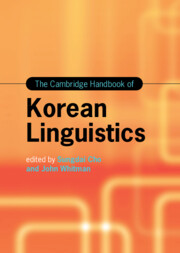Book contents
- The Cambridge Handbook of Korean Linguistics
- Cambridge Handbooks in Language and Linguistics
- The Cambridge Handbook of Korean Linguistics
- Copyright page
- Contents
- Figures
- Tables
- Contributors
- Preface
- Acknowledgments
- Abbreviations
- Part I Korean Overview
- Part II Phonetics and Phonology
- Part III Morphology and Syntax
- Part IV Semantics and Pragmatics
- Part V Sociolinguistics and Psycholinguistics
- Chapter 23 Grammaticalization in Korean
- Chapter 24 Performing Gender in Korean: Language, Gender, and Social Change
- Chapter 25 Jejueo: Korea’s Other Language
- Part VI Language Pedagogy
- Index
- References
Chapter 24 - Performing Gender in Korean: Language, Gender, and Social Change
from Part V - Sociolinguistics and Psycholinguistics
Published online by Cambridge University Press: 30 September 2022
- The Cambridge Handbook of Korean Linguistics
- Cambridge Handbooks in Language and Linguistics
- The Cambridge Handbook of Korean Linguistics
- Copyright page
- Contents
- Figures
- Tables
- Contributors
- Preface
- Acknowledgments
- Abbreviations
- Part I Korean Overview
- Part II Phonetics and Phonology
- Part III Morphology and Syntax
- Part IV Semantics and Pragmatics
- Part V Sociolinguistics and Psycholinguistics
- Chapter 23 Grammaticalization in Korean
- Chapter 24 Performing Gender in Korean: Language, Gender, and Social Change
- Chapter 25 Jejueo: Korea’s Other Language
- Part VI Language Pedagogy
- Index
- References
Summary
Chapter 24 examines the topic of language and gender in the context of Korean studies. Korean is well-known for its highly sophisticated honorifics and other resources that index hierarchy, formality, personal closeness, etc. Korean speakers “perform” gender using politeness distinctions as a primary resource. Studying how gender is performed requires the examination of language and gender in local contexts as they are indexed and constructed. This chapter also looks at the relative frequency of men’s use of formal language such as caney “you”, yey “yes”, and the supnita style, in comparison to women. The result of this is that women may feel like “interlopers” in prestigious professions where formal language is the norm. On the other hand, as Korea is rapidly moving away from a hierarchical society and toward a more egalitarian one, informal language, including caki “you”, ney “yes”, the eyo style, and other patterns associated with women, is becoming preferred over formal language to some extent across genders. This is especially evident among the younger generation.
Keywords
- Type
- Chapter
- Information
- The Cambridge Handbook of Korean Linguistics , pp. 689 - 716Publisher: Cambridge University PressPrint publication year: 2022
References
- 2
- Cited by

